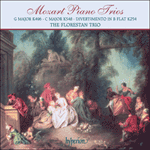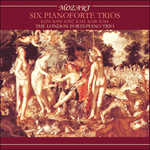
Welcome to Hyperion Records, an independent British classical label devoted to presenting high-quality recordings of music of all styles and from all periods from the twelfth century to the twenty-first.
Hyperion offers both CDs, and downloads in a number of formats. The site is also available in several languages.
Please use the dropdown buttons to set your preferred options, or use the checkbox to accept the defaults.

| The Florestan Trio» More |
The Piano Trio in G major K496 is the first of these mature trios, one of a pair written in 1786 (the other being the trio in B flat K502, see Hyperion CDA67556). Mozart had been living in Vienna for five years and was beginning to enjoy some real success, for the first and only time in his career. The Marriage of Figaro was premiered in May 1786, and was increasingly acclaimed as its run continued. In March he had completed two of his greatest piano concertos, K488 in A major and K491 in C minor. This G major Piano Trio followed in July.
The solo piano introduces the opening theme, which is almost operatic in its fluid decoration. At first, only the violin joins in the dialogue, with the cello fulfilling its traditional role as the bass instrument. But the middle section begins dramatically with all instruments fortissimo, and then quietly the cello leads off the discussion, suddenly taking its place as the equal of piano and violin—a moment that must have been startling to Mozart’s contemporaries. The Andante begins, like the first movement, with an elegantly decorated theme. But the movement that unfolds has unexpected depth and complexity, with sudden modulations and, in the middle section, contrapuntal interweavings that remind us of Mozart’s love of J S Bach and Handel. The finale is a set of variations on a rather stately gavotte. The first three variations proceed innocently, but the fourth variation, in the minor, interrupts the calm with an extraordinary change of tone, the violin reiterating a drone-like motif, the cello repeating a sombre bass line below, and the piano weaving more counterpoint above. The fifth variation is an Adagio, which seems almost to take us back to the slow movement. The final variation brings a return to the gavotte tempo with flamboyant piano arpeggios, and all seems set for a brilliant ending. But the strange drone motif and counterpoint from the fourth variation return, and only just in time Mozart pulls the music back to a cheerful conclusion.
from notes by Robert Philip © 2007
Le Trio avec piano en sol majeur K496 est le premier de ces trios de la maturité, l’un des deux écrits en 1786 (l’autre, le trio en si bémol K502, figure sur le disque Hyperion CDA67556). Installé à Vienne depuis cinq ans, Mozart commençait à jouir d’un vrai succès, pour le première et unique fois de sa carrière. Le mariage de Figaro, créé en mai 1786, fut toujours plus acclamé au fil des représentations. En mars, le compositeur avait achevé deux de ses plus grands concertos pour piano (K488 en la majeur et K491 en ut mineur), bientôt suivis, en juillet, du présent Trio avec piano en sol majeur.
Le piano solo introduit le thème d’ouverture, presque opératique dans sa décoration fluide. Au début, seul le violon participe au dialogue, le violoncelle assumant son rôle traditionnel d’instrument de tessiture grave. Mais la section centrale commence dramatiquement avec tous les instruments fortissimo avant que, paisiblement, le violoncelle n’engage la conversation, se faisant soudain l’égal du violon et du piano—un instant qui a dû surprendre les contemporains de Mozart. Comme le premier mouvement, l’Andante s’ouvre sur un thème élégamment orné. Mais le mouvement qui se déploie présente une profondeur et une complexité inattendues, avec des modulations soudaines et, dans la section centrale, des entrelacs contrapuntiques qui nous rappellent combien Mozart aimait J.S. Bach et Haendel. Le finale est une série de variations sur une gavotte plutôt majestueuse. Les trois premières se déroulent innocemment, mais la quatrième, en mineur, rompt le calme avec un extraordinaire changement de ton: le violon réitère un motif en bourdon et le violoncelle répète une sombre ligne de basse en dessous, tandis que le piano tisse encore du contrepoint au-dessus. La cinquième variation, un Adagio, semble presque nous ramener au mouvement lent, avant que la dernière renoue avec le tempo de gavotte en de flamboyants arpèges pianistiques. Tout paraît annoncer une conclusion brillante, mais l’étrange motif en bourdon et le contrepoint de la quatrième variation reviennent et c’est in extremis que Mozart ramène la musique à une conclusion enjouée.
extrait des notes rédigées par Robert Philip © 2007
Français: Hypérion
Das Klaviertrio in G-Dur KV496 ist das erste dieser reiferen Trios, und eines von zwei, die 1786 geschrieben wurden (das andere ist das Trio in B-Dur KV502, siehe Hyperion CDA67556). Mozart hatte bereits fünf Jahre in Wien gelebt und erfreute sich zum ersten und einzigen Mal in seiner Laufbahn echten Erfolgs. Die Hochzeit des Figaro wurde im Mai 1786 uraufgeführt und im Verlauf ihrer Aufführungen immer höher gepriesen. Im März hatte er zwei seiner größten Klavierkonzerte, KV488 in A-Dur und KV491 in c-Moll, geschrieben. Dieses G-Dur-Trio folgte im Juli.
Das Soloklavier führt das Anfangsthema ein, das mit seinen geschmeidigen Verzierungen nahezu opernhaft anmutet. Zunächst tritt nur die Violine in einen Dialog mit dem Klavier, während das Cello weiter seine traditionelle Rolle als Bassinstrument erfüllt. Aber der Mittelteil beginnt dramatisch, fortissimo in allen Instrumenten, aber dann führt das Cello leise die Diskussion ein und nimmt plötzlich seinen gleichberechtigten Platz neben Klavier und Violine ein—ein Moment, der Mozarts Zeitgenossen wohl überrascht hätte. Wie der erste Satz beginnt auch das Andante mit einem elegant verzierten Thema. Aber der Satz, der sich entfaltet, besitzt unerwartete Tiefe und Komplexität, mit unvermittelten Modulationen und kontrapunktischem Geflecht im Mittelteil, das uns an Mozarts Vorliebe für J. S. Bach und Händel erinnert. Das Finale ist eine Folge von Variationen über eine eher stattliche Gavotte. Die ersten drei Variationen gehen unschuldig vonstatten, aber die vierte Variation in Moll unterbricht die Stille mit einem außerordentlichen Umschlag im Ton, indem die Violine ein bordunhaftes Motiv mit einer düsteren Basslinie des Cellos wiederholt, während das Klavier darüber mehr Kontrapunkt webt. Die fünfte Variation ist ein Adagio, das uns fast zum langsamen Satz zurückzuführen scheint. Die abschließende Variation bringt eine Rückkehr zum Gavottentempo mit extravaganten Klavierarpeggien und alles scheint für ein brillantes Ende bereit. Aber das seltsame Bordun-Motiv und der Kontrapunkt aus der vierten Variation kehren noch einmal wieder, und Mozart gelingt es nur in letzter Sekunde, die Musik zu einem fröhlichen Abschluss zurückzubringen.
aus dem Begleittext von Robert Philip © 2007
Deutsch: Renate Wendel
 Mozart: Piano Trios K496, 548 & 254 Mozart: Piano Trios K496, 548 & 254‘At the start of K548's airy finale, Susan Tomes' gracefully demure piano is swiftly countered by Anthony Marwood's raffish forte riposte: and this se ... ‘These are certainly performances to be treasured, with the playing unfailingly stylish and full of imaginative touches … their new recording can ...» More |
 Mozart: Six Piano Trios Mozart: Six Piano Trios |

